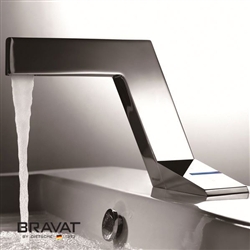How to Clean Touchless Sensor Faucet
A sparkling, newly cleaned sink faucet may make your kitchen or bathroom appear to be worth a million dollars.Over time, stains and spots on faucets may develop Water stains, which diminish the finish, can also be caused by cleaning with soap and water. Difficult to remove with regular soap and water.It is feasible to remove these stains and restore the appearance of your faucets.
Touchless sensor faucets, like most things, do not stay clean indefinitely, and the dreaded buildup of grime and sludge will eventually return. Sensor faucets are prone to microbiological development in addition to unsightly dirt.Microbes can have a detrimental impact on your faucets since they can produce issues, including surface stains and odors.If you use a scouring pad or any other abrasive material or cleaner, the finish will be scratched. To clean hard-to-reach areas on the faucet, use a toothbrush.
Most of the items you'll need to clean any type of finish on your faucets are probably already in your home.Wrap some paper towels over the faucet after dampening them with vinegar. Allow 10 minutes for the towels to dry. Vinegar cleans and disinfects the faucet, and because it is a gentle acid, neither you nor your faucet will be harmed.Dry your faucet after wiping it down with plain water.Using only a towel, apply a small amount of layer of baby oil to your faucet. Only a few drops of oil are required. This will help prevent future water stains and is especially beneficial for chrome or stainless steel finishes.
|
|

|
|
|
|

|
|
How to Clean Touchless Sensor Faucet?
Cleaning a touchless sensor faucet is not only essential for its aesthetics but also for its functionality
and hygiene. To start, gather necessary supplies: a soft cloth or sponge, mild dish soap or a gentle
bathroom cleaner, white vinegar, toothbrush or soft-bristle brush, and paper towels. Begin by turning
off faucet if it has an on/off handle to prevent any accidental water flow during the cleaning process.
Then, remove any loose debris or dirt from the faucet's surface using a soft cloth or sponge. Next,
mix small amount of mild dish soap or a bathroom cleaner with warm water. Dip the cloth or sponge
into soapy water mixture and gently scrub the faucet's surface. Pay close attention to areas around
the sensor and any crevices where grime might accumulate. Afterward, rinse the cloth or sponge
thoroughly and wipe down the faucet again to ensure no soap residue remains.

For a more thorough cleaning of the sensor area, use a toothbrush or soft-bristle brush. Be careful not
to apply excessive pressure to avoid damaging sensor. If you encounter stains or buildup on the sensor,
wet toothbrush with a mixture of equal parts water and white vinegar. Gently scrub the sensor area and
rinse with clean water. If your faucet has an aerator, follow the manufacturer's instructions to remove it
and clean it separately. Soak the aerator in a vinegar and water solution to remove any mineral deposits
or debris. After cleaning, use a dry paper towel or a clean, dry cloth to thoroughly wipe down faucet and
sensor area, ensuring there is no moisture left behind. If your touchless faucet is powered by batteries
or an electrical connection, restore power as necessary.

Before using the faucet again, test the sensor by waving your hand in front of it to check
if it activates the water flow. Regularly perform this cleaning routine, ideally once a month
or as needed, to prevent the buildup of grime and maintain the faucet's functionality.
|
|
|